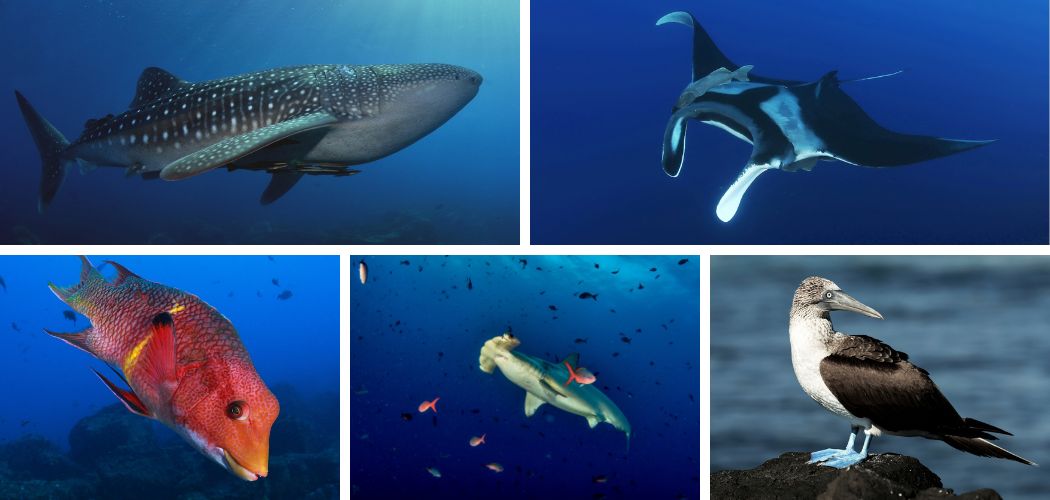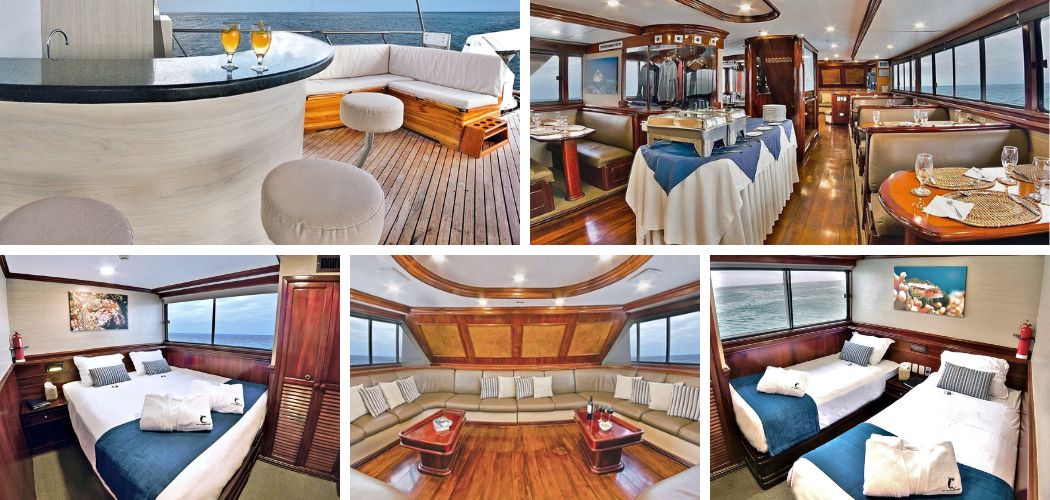 DARWIN & WOLF EXTENDED
DARWIN & WOLF EXTENDED
Unforgettable encounters
Spaces available 2023 & 2024
Does a 7-day itinerary in Galapagos seem a bit insufficient to you? Each year there are limited opportunites to join 10-day voyages (and even, occasionally, an exotic 14-night trip). On a 10-night voyage, you can expect up to 30 dives in these enchanted waters, with extra time at Darwin & Wolf.
WHY 10 NIGHTS ?
The extended trips offer added time at Darwin & Wolf … every diver’s dream come true. They take in all the best of the Galapagos – including more of the spectacular diving at Darwin and Wolf Islands – with up to 4 dives per day, night dives & land visits.
The custom itineraries will include everything you’ve always longed to see … or to see again. You’ll dive amongst hundreds of hammerheads and look up to see a whale shark cruising along. Add silky sharks, enormous Galapagos sharks, eagle rays, manta rays & mola-mola …. sea turtles, giant morays and schooling fish in the thousands … Then, too, you’ve got black coral with plenty of macro life -seahorses, blennies, nudibranchs, hawkfish and frogfish. Everyone loves the enigmatic sea iguanas, the penguins racing around at full speed and playful sea lions.

10-NIGHT TRIPS AVAILABLE IN 2023 & 2024
GALAPAGOS SKY
DATES, RATES AND GENERAL ITINERARY
{slider A few spaces are available on trips in 2022. … click to read more ….|dest|closed}
2023 rate: from $ 9450 per person
2024 rate: from $ 9900 per person
On a typical day, the Master offers up to 4 day dives, although the 4th dive may be a night dive if the boat is anchored within a sheltered cove. A 7-night itinerary provides for between 18-20 dives while on the 10-night itineraries up to 30 dives will be possible. The diving day aboard the Galapagos Master is scheduled as follows:
- light breakfast followed by a briefing and Dive 1
- full breakfast, relaxation period, briefing and Dive 2
- lunch, relaxation period, briefing and Dive 3
- snack relaxation period, briefing and – if possible – Dive 4
- dinner
To allow guests to explore the Galapagos to its fullest, on days 2, 7 and 10, dives 3 and 4 will be substituted by an island visits at North Seymour, Santa Cruz or Isla Isabela. {/sliders}
DIVE SITE DESCRIPTIONS
{slider We’ve included here a despription of each site you’re likely to dive and the cast of characters you’re likely to meet. As always, this is subject to weather & sea conditions and remains at the discretion of the captain. You will have all the usual diver sites with more time at Darwin and Wolf … click to read more ….|dest|closed}
Punta Carrion – This boulder strewn reef provides a superb introduction to some of the larger pelagics you can expect to see in the Galapagos, including white tip reef sharks but also the occasional hammerhead and Galapagos shark. Sea lions are ever-present and there is the opportunity for some macro critter spotting with sightings of neon nudibranchs. The wall has an average depth of 15m (50ft) and mild- medium current is to be expected.
Wolf Island – Named after the German geologist, Theodor Wolf, this extinct volcano reaches 253m (780ft) above sea level and lies some 160km (100 miles) northwest of Isabela Island. Land visits are not permitted however bird life, including red-footed boobys and vampire finch, may be spotted from the boat.
For the dives here the Master crew offers a selection of reefs and walls, most having typically medium to strong currents where the use of gloves and reef hooks is advised. Schooling pelagics are the main draw with sightings of hammerheads, white tips and Galapagos sharks at each site. During the season (May – November). Galapagoswhale sharks may also be seen here. Divers should also be on the lookout for red-lipped batfish, barracudas, moray eels and dolphins!
Darwin Island – This extinct volcano reaching 165m (490ft) above sea level was named in honour of naturalist Charles Darwin. It is amongst the smallest island within the Galapagos Archipelago and like Wolf Island, no land visits are permitted.
Perhaps the most famed dive site is “Darwin’s Arch” which provides an amazing drift dive along the wall at an average depth of just 9m. Medium to strong currents are to be expected but bring with them hammerheads, black tips, silky and Galapagos sharks – and in large numbers! Schools of jacks are a common sight, along with turtles, angelfish and moray eels. Occasional sightings of tiger sharks, manta rays and bottle nose dolphins make for a thrilling time spent here. Whale sharks may also be seen between May – November.
Douglas Cape – Situated on the northwest point of Fernandina Island, this wall dive, with an average depth of 20m (70ft), offers something truly spectacular and is now famed for the feeding marine iguanas that congregate here along with sea lions, fur seals and speedy penguins!
Punta Vicente Roca – Alternatively known as “The Ice Box”, due to its chilling thermoclines, this point off the Northwest coast of Isabela Island offers a wall drift dive, along which mola mola can be spotted. The occasional Port Jackson shark may also be seen as well as the endemic Camotillo (White spotted sand bass).
Roca Redonda – This underwater volcano, with its bubbling streams of natural gas (fumaroles) plays home to schools hammerheads sharks and barracuda. With typically strong, changeable currents and some down currents, the diving here is challenging, though with an average depth of 18m (60ft).
Cabo Marshall –The craggy volcanic walls are covered with black coral bushes and the sheer variety of marine life is astounding. Sightings of manta, mobula and cownose rays are to be expected during the warm season (November – May). Meanwhile shark varieties include scalloped hammerhead, Galapagos and white tips. Let’s not forget the sea lions and turtles!
Cousin’s Rock– One of the most photographically productive dives of the region, Cousin’s Rock is formed of coral covered rock and lava flow. Sea fans, hydroid bushes, red sponges and small hard corals encrust ledges and overhangs, sheltering hawkfish, nudibranchs, frogfish and seahorses. Plenty of larger visitors are also seen including giant manta and mobula rays, spotted eagle rays and hammerhead sharks. The wall drops beyond 30m (100ft) but rises up shallow to just 3m (10ft) providing an ideal spot to end your dive playing with the sea lions.
Tagos Cove – On the west side of Isabela Island, opposite Fernandina Island, this shallow reef is an excellent late afternoon dive, where you have the opportunity to find seahorses, frogfish and long nosed hawk fish.
Punta Albermale – Drifting along this wall on the north of Isabela Island, you stay at an average depth of 25m (85ft) to see manta rays, hammerheads, turtles, schools of barracuda and tuna. {/sliders}
 REQUIREMENTS FOR ENTERING GALAPAGOS ….
REQUIREMENTS FOR ENTERING GALAPAGOS ….
Galapagos has very specific requirements for entry. This is due to the effort to manage the impact of both residents and visitors on the islands and their wildlife.
Prior to entry into Galapagos – ALL visitors MUST have the following:
- round-trip ticket
- reservations in a hotel or on a cruise which correspond EXACTLY to the dates of your airline tickets
- (or) an invitation letter to remain as a guest of a permanent or temporary resident in Galapagos for no more than 60 days in a year
- immigration card (known as the Ingala card) issued by the Galápagos Special Regime Governing Council.
* The requirements must be presented to & accepted by the Governing Council at Quito or Guayaquil airport upon entry. You will then receive your Ingala (immigration) card.
If you are on a dive liveaboard (or liveaboard naturalist cruise) you will NOT be allowed to spend time on the islands before or after your cruise UNLESS you have made prior reservations. We will be happy to advise you regarding accommodation on the islands.
